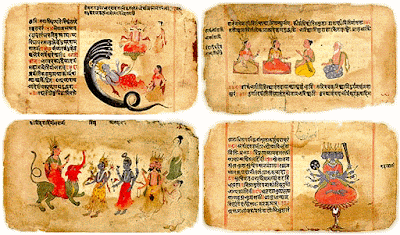Vedic Literature
 |
The word ‘Veda’ is derived from the root ‘vid’, which means to know. In other words, the term ‘Veda’ signifies ‘superior knowledge’. The Vedic literature consists of the four Vedas – Rig, Yajur, Sama and Atharva.
The Rig Veda is the earliest of the four Vedas and it consists of 1028 hymns. The hymns were sung in praise of various gods. The Yajur Veda consists of various details of rules to be observed at the time of sacrifice. The Sama Veda is set to tune for the purpose of chanting during sacrifice. It is called the book of chants and the origins of Indian music are traced in it. The Atharva Veda contains details of rituals.
(Ramayana and Mahabharata)
Besides the Vedas, there are other sacred works like the Brahmanas, the Upanishads, the Aranyakas and the epics Ramayana and Mahabharata. The Brahmanas are the treatises relating to prayer and sacrificial ceremony.
(Brihadaranyaka Upanishad)
The Upanishads are philosophical texts dealing with topic like the soul, the absolute, the origin of the world and the mysteries of nature. The Aranyakas are called forest books and they deal with mysticism, rites, rituals and sacrifices. The author of Ramayana was Valmiki and that of Mahabharata was Vedavyas.





Comments
Post a Comment